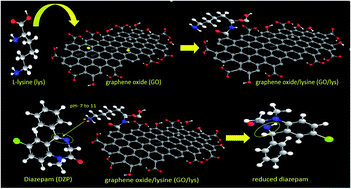Graphene oxide/lysine composite – a potent electron mediator for detection of diazepam†
Abstract
In the context of the wide misuse of benzodiazepine drugs, this work is an attempt to sense diazepam, which is the most exploited drug molecule amongst this class. A graphene oxide/lysine (GO/lys) composite, synthesized using a very simple chemical method, has been used to modify a glassy carbon electrode (GCE) for the voltammetric detection of diazepam (DZP). The synthesized composite has been characterized using Fourier transform infrared (FT-IR) spectroscopy, X-ray diffraction (XRD), field emission electron microscopy-energy dispersive X-ray (FESEM-EDX) spectroscopy, electrochemical impedance spectroscopy (EIS), and cyclic voltammetry (CV). The detection of diazepam has been carried out using electrochemical techniques like differential pulse voltammetry (DPV) and CV. The synthesized composite substantially enhanced the electrocatalytic performance of the fabricated sensor. The detection of DZP in varied pH environments (2 to 11) involved a proton dependent mechanistic approach. The linear detection range (LDR), limit of quantitation (LOQ), and limit of detection (LOD), obtained by measuring the increase in the electrocatalytic current with the corresponding increase in the concentration of diazepam, have been calculated as 350 μM to 0.17 μM, 156 nM and 46 nM, respectively. Furthermore, the proposed system demonstrated very good stability and repeatability. This work presents a fairly good limit of detection compared to previous reports, with a simple yet very effective electrode modifier for DZP detection. The detection of spiked DZP in soft and hard drinks without any pre-treatment procedures has also been demonstrated with significant detection limits without any interference from the excipients.

- This article is part of the themed collection: Electrochemistry for health applications


 Please wait while we load your content...
Please wait while we load your content...